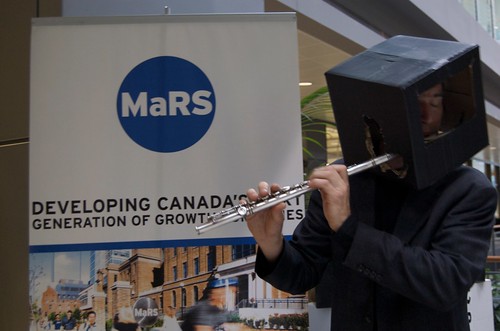
It was another fruitful day at the Creative Places and Spaces: Collaborative City Conference, today in the light-filled MaRS building. Beginning with Welcoming & Opening Remarks by Ilse Treurnicht, CEO MaRS, Joseph L. Rotman, Chair, Canada Council for the Arts and Simon Brault, Vice-Chair, Canada Council for the Arts, we heard about the difference between invention and innovation
Brault asked, “How do you make it real, how do you come to the point where those ideas are transforming the society, reshaping the cities in which we live?” He answered himself by saying that it “means a lot of collaboration, a lot of involvement, you need time, you need to be persuasive.” He added, with relation to challenges of coming from a family of many children, similar to Ken Robinson and Charles Landry, “if you don’t collaborate, you die, you don’t go anywhere.”
The first Video Spotlight of the day was by Luigi Ferrara, director at the School of Design at George Brown College, entitled The Transformation of Montreal. He explained that the transformation in Montreal was possible because of a collaboration between arts groups and all levels of government. His key ideas were that “when you’re not rich you have to make sure things will last,” and that “artists don’t ask where they come from, but what they want to do together.”
Robin Cardozo, CEO of the Ontario Trillium Foundation, said that “opposing collaboration these days is like opposing motherhood and apple pie,” but spoke about key ideas to keep in mind. “It only works when it makes sense. Forced collaborations, marriage of convenience, shotgun weddings, almost never work.” He asked delegates to look beyond their own backyard for collaboration partners, as the outcomes are usually the most interesting.

On that note, David Buckland, artist, environmentalist, and founder of Cape Farewell, presented his work collaborating with artists, musicians, poets, and scientists. Presenting beautiful images and words, leading to another standing ovation, his message was about using collaboration to spread a message and create a global dialogue.
Lyn Heward, Consultant and Executive Producer of Cirque du Soleil, focused on seven ideas to getting good collaboration: having great expectations; surrendering to your senses; treasure hunting and creative transformation; the nurturing environment; how constraints, challenges, differences and consumer expectations become creative catalysts; risk-taking: do you ever get burned; and keeping it fresh. She also said that “good ideas can emerge from anywhere within the organization or team, ” and “there’s always more than one way of doing things” — relating to Sir Ken Robinson’s remark on Day One about how if you’re getting stuck, maybe your not asking the right question or looking at the problem from the right angle.

Like a contemporary British invasion, the next Keynote Speaker, Charles Landry, author, urban thinker, and founder of Comedia, spoke about Creative Bureaucracy, which he described as “two words seemingly in tension.” But he pointed out that there is a realignment that people are trying to bring out, and touched on the idea that “the city is greater than the sum of its parts,” and how individuals and organizations need to align their mindsets. In closing, he stated, “vision shapes rules, not rules vision,” and pushed the idea of “unlearning,” to which he said, “unlearning is an incredibly important thing; art can be a jolt to sort of try and turn the perspective around in some sort of way.” These ideas related closely to what Robinson spoke about on Day One, with the effect that our education system has on our creativity and the need to question these methods. In the discussion between Landry, Heward and Buckland, Buckland said, “you can’t solve a problem with the same thinking that caused it.”
Playing the City, a Video Spotlight by Matthias Ulrich of Frankfurt, examined the questions of how the public participates in the political dialogue, and what is meant by public space. According to Ulrich, in recent years, terms such as participatory and collaborative have changed the way we approach design. These changes are evident in public art installations, such as A Wall is a Screen, where films, with specific cultural and urban contexts, help to produce thought provoking theatre.
During the afternoon, there was a chance to break off into smaller groups with the Breakthrough Sessions. The panel on Collaborative Governance with City Councilor Adam Vaughan, Devon Ostrom, Paul Born and David Wolfe discussed the need for leaders to engage and support collaboration. Asked by an audience member about the challenges of defining collaboration versus partnerships, Born replied by saying, “collaboration is like sex, it’s like mold feeding of each other and becoming more.” Speaking about the differences in scale between cities in Toronto, Born furthered this by saying, it’s, “not a questions of scale, its how you enter into a system and how that system is able to absorb a new idea.”
In the final summary, the panel listed their highlights and what they will bring away from the conference. With the challenge of managing different interests, Tonya Surman, of the Centre for Social Innovation explained that organizations must ask what their converging interests are, which are not necessarily common interests. It was clear that the conversation on collaboration has been started but a strategy for implementation needs to be the next steps.
Photos by Artscape Toronto
